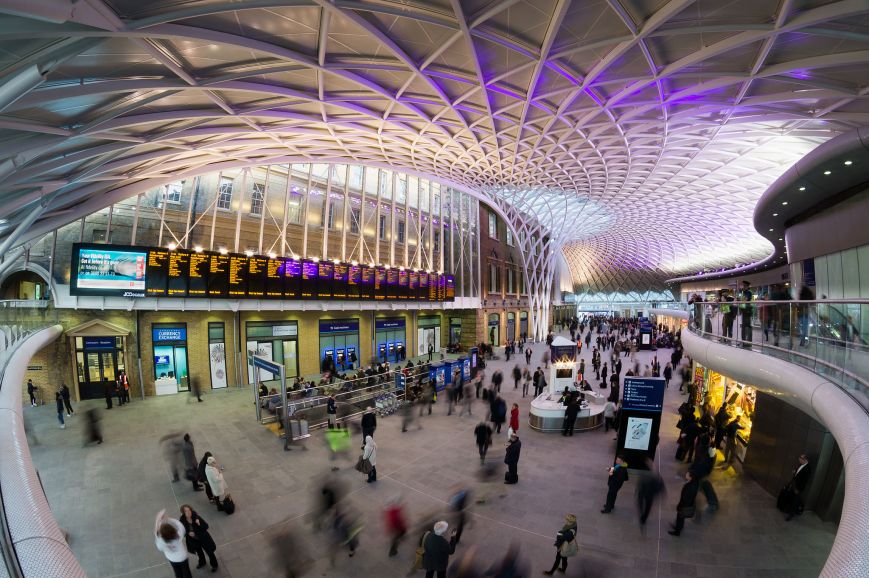
King’s Cross Station, London © User:Colin / Wikimedia Commons, via Wikimedia Commons
From Roman roads, to Victorian ‘cathedrals of steam’, transport has played a pivotal role in the development of societies and economies throughout history.
Today, rising energy prices, road congestion, and climate change, as well as reduced household sizes and an increased demand for urban living have put the potential benefits of urban transport hubs back in the spotlight.
Transit-orientated development
Transit-orientated development (TOD) is one response. An American-concept, it involves the creation of high-density mixed-use developments around a transit station or stop, such as a railway station, usually within a half-mile radius (a 10-minute walk approximately). It may include office space, retail, leisure facilities and housing, as well as public areas and green space, and a variety of public transport options.
The aim is to create attractive, diverse, walkable places. TOD can also help to significantly reduce traffic congestion and air pollution.
Stations as ‘destinations’
In Europe, TOD has yet to ‘catch on’. However, it shares many similar principles with the increasingly popular concept of developing railway stations as destinations in their own right – for shopping, working and socialising. Railways often form an important part of a town or city centre, and the combination of transport node and central location has the potential to attract people in great numbers.
The redevelopment of London King’s Cross station and the surrounding industrial wasteland made it one of the first ‘destination stations’ in the UK. Around the station, new homes, shops, offices, galleries, bars, restaurants, a hotel, schools and a university were created, along with 20 new streets, 10 new public parks and squares, and 26 acres of open space. In fact, the redevelopment was on such a scale that the area now has its own postcode – N1C.
Some other key examples of newly developed ‘destination stations’ in the UK include Manchester Victoria Station and Birmingham New Street Station. Network Rail last year stated that they intend to create many more such ‘destination stations’.
Economic and social benefits
As well as environmental benefits such as reduced air pollution and traffic congestion, mixed-use developments in and around railway stations can help meet housing demand, and spur the economic and social regeneration of their surrounding communities. Particular benefits can include:
- Improved passenger experience/satisfaction
- Attracting more businesses into an area
- Improving the supply of labour for businesses
- New job creation
- Increased demand for food, retail and leisure facilities from greater numbers of commuters, residents and workers
- Helping high streets to compete with online retailers and out of town developments
- Contributing to public health goals through increased walkability of areas
- Making good use of previously inaccessible/waste land
Government support
There is strong government support for delivering improvements around railway stations.
The recent Housing white paper recognises the regenerative potential of railway stations, viewing them as key anchors for the next generation of urban housing developments.
Two new sources of funding for railway station developments have also recently been announced: the second round of the New Stations Fund – a £20 million pot to build new stations or reopen previously closed stations; and the Station Regeneration programme – which aims to develop railway stations and surrounding land, while delivering up to 10,000 new homes.
Alongside this, there are also plans to release large amounts of unused railway land for housing – enough to build 12,000 houses across 200 sites.
Large and small
In addition to developments focused around one particular station or city, there are also a number of major railway-based infrastructure projects currently taking place. Among these are the Edinburgh-Glasgow Improvement Programme (including recently approved plans to redevelop Glasgow Queen Street station), Great Western Electrification, Crossrail and HS2. All of these have the potential to catalyse regeneration in their surrounding areas.
At the opposite end of the spectrum, there are also a number of successful smaller scale regeneration projects involving railways.
Addressing the challenges
The development of railway sites can pose a number of challenges, including contaminated land, fragmented land ownership and reconciling short-term economic development goals with the longer time scales necessary in larger infrastructure projects.
However, according to James Harris, a policy officer at the Royal Town Planning Institute, planners are ‘uniquely’ placed to work with landowners, infrastructure providers, developers and the local community to help deliver a strategic vision for these locations.
Planners should also be flexible and creative in their approach towards station redevelopments, focusing on outcomes rather than processes, says David Crook, assistant director of station regeneration at the Department for Business, Energy and Industrial Strategy’s Cities and Local Growth Unit. In doing so, he says, planners can help make a station regeneration project ‘more than the sum of its parts’.
Follow us on Twitter to see what developments in public and social policy are interesting our research team. If you enjoyed this article, you may also be interested in our blog post ‘Reimagining travel: how can data technologies create better journeys?‘

You must be logged in to post a comment.